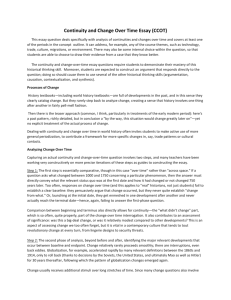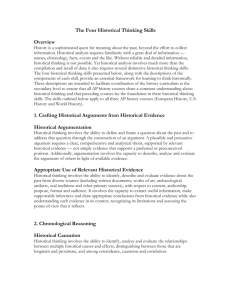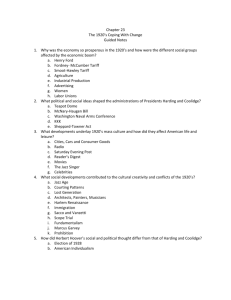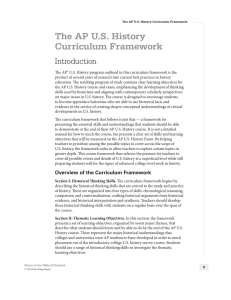Strategies for the “Continuity & Change Over Time” Question
advertisement
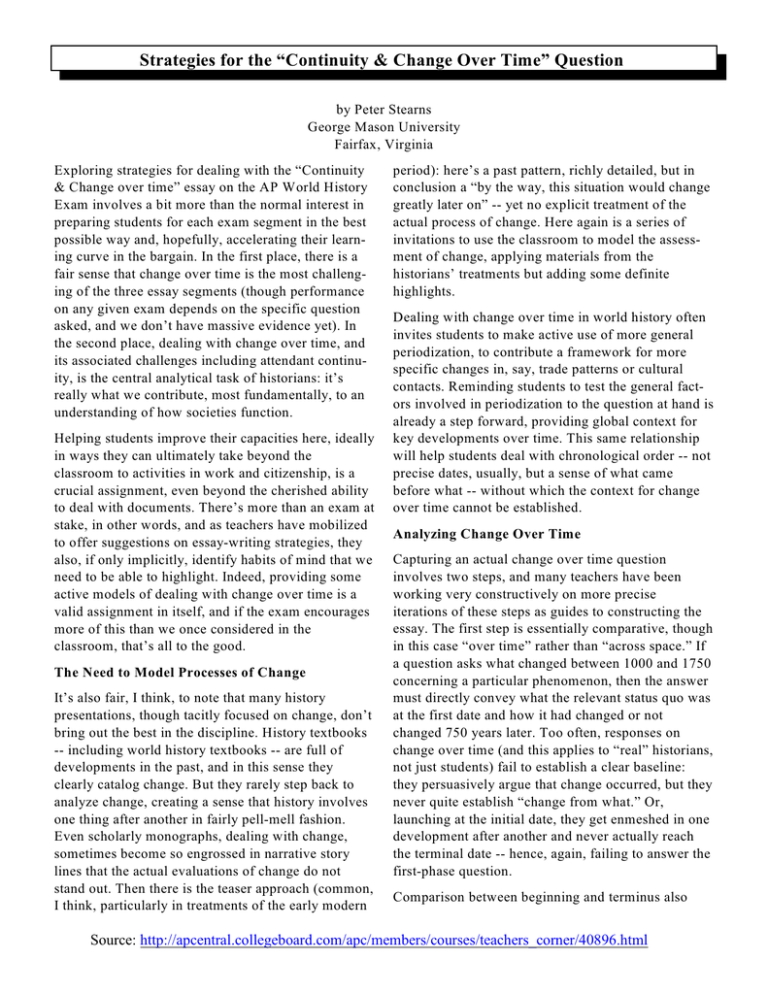
Strategies for the “Continuity & Change Over Time” Question by Peter Stearns George Mason University Fairfax, Virginia Exploring strategies for dealing with the “Continuity & Change over time” essay on the AP World History Exam involves a bit more than the normal interest in preparing students for each exam segment in the best possible way and, hopefully, accelerating their learning curve in the bargain. In the first place, there is a fair sense that change over time is the most challenging of the three essay segments (though performance on any given exam depends on the specific question asked, and we don’t have massive evidence yet). In the second place, dealing with change over time, and its associated challenges including attendant continuity, is the central analytical task of historians: it’s really what we contribute, most fundamentally, to an understanding of how societies function. Helping students improve their capacities here, ideally in ways they can ultimately take beyond the classroom to activities in work and citizenship, is a crucial assignment, even beyond the cherished ability to deal with documents. There’s more than an exam at stake, in other words, and as teachers have mobilized to offer suggestions on essay-writing strategies, they also, if only implicitly, identify habits of mind that we need to be able to highlight. Indeed, providing some active models of dealing with change over time is a valid assignment in itself, and if the exam encourages more of this than we once considered in the classroom, that’s all to the good. The Need to Model Processes of Change It’s also fair, I think, to note that many history presentations, though tacitly focused on change, don’t bring out the best in the discipline. History textbooks -- including world history textbooks -- are full of developments in the past, and in this sense they clearly catalog change. But they rarely step back to analyze change, creating a sense that history involves one thing after another in fairly pell-mell fashion. Even scholarly monographs, dealing with change, sometimes become so engrossed in narrative story lines that the actual evaluations of change do not stand out. Then there is the teaser approach (common, I think, particularly in treatments of the early modern period): here’s a past pattern, richly detailed, but in conclusion a “by the way, this situation would change greatly later on” -- yet no explicit treatment of the actual process of change. Here again is a series of invitations to use the classroom to model the assessment of change, applying materials from the historians’ treatments but adding some definite highlights. Dealing with change over time in world history often invites students to make active use of more general periodization, to contribute a framework for more specific changes in, say, trade patterns or cultural contacts. Reminding students to test the general factors involved in periodization to the question at hand is already a step forward, providing global context for key developments over time. This same relationship will help students deal with chronological order -- not precise dates, usually, but a sense of what came before what -- without which the context for change over time cannot be established. Analyzing Change Over Time Capturing an actual change over time question involves two steps, and many teachers have been working very constructively on more precise iterations of these steps as guides to constructing the essay. The first step is essentially comparative, though in this case “over time” rather than “across space.” If a question asks what changed between 1000 and 1750 concerning a particular phenomenon, then the answer must directly convey what the relevant status quo was at the first date and how it had changed or not changed 750 years later. Too often, responses on change over time (and this applies to “real” historians, not just students) fail to establish a clear baseline: they persuasively argue that change occurred, but they never quite establish “change from what.” Or, launching at the initial date, they get enmeshed in one development after another and never actually reach the terminal date -- hence, again, failing to answer the first-phase question. Comparison between beginning and terminus also Source: http://apcentral.collegeboard.com/apc/members/courses/teachers_corner/40896.html 2 Strategies for the “Continuity & Change Over Time” Question directly allows for continuity -- the “what didn’t change” part, which is so often, quite properly, part of the change over time interrogation. It also contributes to an assessment of significance: was this a big-deal change, or was it relatively modest compared to other developments? This is an aspect of assessing change we too often forget, but it is vital in a contemporary culture that tends to tout revolutionary change at every turn, from lingerie designs to security threats. The second phase of analysis, beyond before and after, asks students to get involved with the process of change, the intervening developments that add real flesh to what otherwise will seem too cut and dried. Process involves, among other things, identifying the major relevant developments that occur between baseline and endpoint. Change relatively rarely proceeds smoothly; there are interruptions, even back eddies. Globalization, for example, accelerated rapidly by many relevant definitions between the 1860s and 1914, only to roll back (thanks to decisions by the Soviets, the United States, and ultimately Mao as well as Hitler) for 30 years thereafter, following which the pattern of globalization changes emerged again. Change usually receives additional stimuli over long stretches of time. Since many change questions also involve causation, this is an opportunity to talk about significant intervening factors that may accelerate the change, push it in slightly different directions, delay it for a while, or do all the above. Periodization and the AP World History Examination The real point of this second phase of analysis involves internal periodization: take a given topic (international trade patterns 1000-1750), identify baseline and end point, and then talk about the major internal subdivisions (based on new factors), additional directions, and even interruptions. Many teachers are urging their students to identify some midpoint in order to avoid simply dealing with beginning and end; the advice is well intended and surely will help a bit. Unfortunately, formulas have limits here: each question requires relevant knowledge about when the internal breaks occur and on what basis they can be identified. An early AP World History question thus asked about changes in international trade relations, 1750 to present, in several regions (pick two). For Latin America, breaks would surely be identified around independence-cumnew-British-imports, and again in the 1930s and 1940s, when countries like Brazil, thanks to import substitution and some new export diversity, began gaining slightly greater voices in the terms of trade. For Africa, on the other hand, the end of slave trade and then the intensification of Western exploitation from the late nineteenth century onward would make more sense. The same analytical issue is present in both cases, but obviously leads to rather different responses. Practice will help, along with appropriate knowledge, but overrigid answer formulas could mislead. And indeed, practice and classroom modeling provide the obvious lessons here, applicable to contemporary cases where major change is claimed as well as to the past. We need experience and experiments in getting students to outline their approach to questions about change over time (including, as appropriate, causation, significance, and/or continuity), while also undertaking full essays a bit more selectively. Even pausing in a coverage session to ask what was really changing here, and why, and what was persisting, will help students meet the challenge of turning descriptive facts into building blocks that permit analysis of change. It will be interesting to see if AP teachers can not only improve essay results (already showing some positive signs of good coaching), but also accelerate both the learning curve and the capacity to retain a crucial historical habit of mind beyond the classroom. Peter Stearns is the chair of the AP World History Development Committee as well as a coauthor of several world history textbooks and the editor of the Encyclopedia of World History. He is also the provost of George Mason University. This article is an expanded version of remarks he delivered to a session on AP World History at the 2004 annual conference of the National Council for the Social Studies. Source: http://apcentral.collegeboard.com/apc/members/courses/teachers_corner/40896.html
